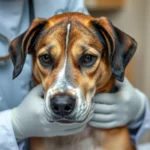
Introduction
Dog cavities, much like those in humans, are areas of decay on a tooth’s surface caused by a combination of bacteria, plaque buildup, and dietary factors. While the mechanics of how cavities form are similar, the specifics of dental health in dogs can differ significantly from that of humans. Understanding these differences is crucial for pet owners looking to maintain their furry friends’ overall health.
Dental health in dogs is often overlooked, yet it plays a critical role in their overall well-being. Poor dental hygiene can lead to serious health issues, including heart, liver, and kidney problems. Statistics indicate that approximately 80% of dogs over the age of three show signs of dental disease, highlighting the need for vigilant dental care.
In this article, we will provide insights from veterinary experts to help you understand dog cavities, their causes, symptoms, diagnosis, treatment options, and preventive measures.
Understanding Dog Cavities
What Causes Cavities in Dogs?
Bacterial Infection
Cavities in dogs typically start with the accumulation of plaque, a sticky film of bacteria that forms on teeth. If not removed through regular brushing or professional cleaning, plaque can harden into tartar, which can lead to gum disease and cavities. The bacteria in plaque produce acids that erode tooth enamel, creating cavities.
Dietary Factors
The type of food your dog consumes also plays a significant role in their dental health. Dogs that primarily eat sugary or soft foods are more prone to cavities, as these diets do not provide the abrasive action needed to clean teeth naturally. Additionally, a lack of crunchy treats can contribute to plaque buildup.
Genetic Predisposition
Certain breeds are more susceptible to dental issues than others. Smaller breeds, such as Chihuahuas and Yorkshire Terriers, often experience more dental problems due to their smaller mouths, which can lead to overcrowding and increased plaque retention.
Symptoms of Dog Cavities
Behavioral Changes
If your dog is experiencing a cavity, you may notice changes in their eating habits. They might be reluctant to chew on hard food or toys, showing signs of discomfort or pain. Watch for behaviors such as pawing at their mouth or excessive drooling.
Physical Signs
Bad breath is one of the most noticeable early signs of dental issues in dogs. Additionally, swollen or bleeding gums and visible decay on the teeth can indicate the presence of cavities. Owners should regularly check their dog’s mouth for these signs.
Advanced Symptoms
As cavities progress, they can lead to more severe issues such as abscesses and infections. If your dog develops a swelling on their face or exhibits signs of pain, such as whining when touched, it is crucial to seek veterinary attention immediately.
Diagnosing Dog Cavities
Veterinary Examination
Importance of Regular Check-Ups
Regular veterinary check-ups are vital for maintaining your dog’s dental health. Most vets recommend annual dental exams, but dogs with a history of dental issues or those over a certain age may require more frequent visits.
What to Expect During a Dental Exam
During a dental exam, your vet will use specialized tools to examine your dog’s teeth and gums. They may perform a visual inspection and use instruments to probe for any signs of decay or disease. This proactive approach can help catch cavities early before they lead to more serious health concerns.
Diagnostic Tools
X-Rays
X-rays are invaluable in diagnosing cavities that are not visible during a standard oral examination. They can reveal decay beneath the surface of the teeth and help your vet assess the extent of any damage.
Oral Assessment
Along with X-rays, a thorough oral assessment is essential. This includes a visual inspection of the teeth and gums, checking for any signs of inflammation or infection, and probing for soft spots that indicate decay.
Treatment Options for Dog Cavities
Professional Dental Cleaning
Importance of Scaling and Polishing
Once cavities are diagnosed, the primary treatment option is usually a professional dental cleaning. This process involves scaling to remove plaque and tartar buildup from the teeth, followed by polishing to smooth the surfaces. This not only helps treat existing cavities but also prevents their formation.
Fillings and Restorative Procedures
When Are Fillings Necessary?
In some cases, if a cavity is detected before it leads to significant decay, a filling may be necessary. This restorative procedure can help preserve the tooth structure and prevent further complications. Your vet will assess the extent of the cavity and recommend the best course of action.
Tooth Extraction
When Is Extraction the Best Option?
In cases where the cavity is extensive and has caused significant damage, extraction may be the best option. Your vet will consider factors such as the tooth’s location, your dog’s age, and overall health when making this decision. While tooth extraction can seem daunting, it can often relieve pain and prevent further health issues.
Preventing Dog Cavities
Dental Care at Home
Daily Brushing
One of the most effective ways to prevent dog cavities is through daily brushing. Using a toothbrush and toothpaste specifically designed for dogs can help remove plaque before it hardens into tartar. Aim for at least a few times a week, if not daily.
Dental Chews and Toys
Incorporating dental chews and toys into your dog’s routine can also be beneficial. These products are designed to help reduce plaque and tartar buildup while providing entertainment and mental stimulation for your pet.
Diet and Nutrition
Choosing the Right Food
Selecting a high-quality diet can significantly impact your dog’s dental health. Look for dog foods formulated to promote dental health, which often contain ingredients that help reduce plaque buildup. Avoid sugary treats that can contribute to cavities.
Water Additives and Dental Treats
Consider using water additives designed to promote dental health. These can help reduce plaque and improve breath. Additionally, dental treats specifically formulated to support oral health can be a tasty addition to your dog’s diet.
Regular Veterinary Visits
Establishing a Routine
Establishing a routine for dental check-ups is essential. Regular visits to the vet for dental assessments can help catch problems early, ensuring your dog maintains a healthy mouth and preventing the development of cavities.
Frequently Asked Questions (FAQs)
Can Dogs Get Cavities Like Humans?
Yes, dogs can develop cavities, although the process and contributing factors may differ from those in humans. While dogs do not typically experience cavities as frequently as people, dental disease is still a common concern.
How Often Should I Get My Dog’s Teeth Checked?
Most dogs should have their teeth checked at least once a year. However, if your dog is older or has a history of dental issues, more frequent check-ups may be necessary.
Are Certain Breeds More Prone to Cavities?
Yes, smaller breeds such as Dachshunds, Chihuahuas, and Yorkies are typically more prone to dental issues, including cavities. Their smaller mouths can lead to crowded teeth, making it easier for plaque to accumulate.
What Should I Do If I Suspect My Dog Has a Cavity?
If you suspect your dog has a cavity, observe their behavior for signs of discomfort and make an appointment with your veterinarian as soon as possible. Early intervention is key to effective treatment.
Conclusion
Maintaining your dog’s dental health is essential for their overall well-being. Recognizing the signs of dog cavities and understanding how to prevent them can lead to a happier, healthier life for your pet. Regular veterinary check-ups, a proper dental care routine at home, and a balanced diet are all crucial in keeping your dog’s smile bright and healthy. If you have concerns about your dog’s dental health, don’t hesitate to consult your veterinarian for guidance and support.









